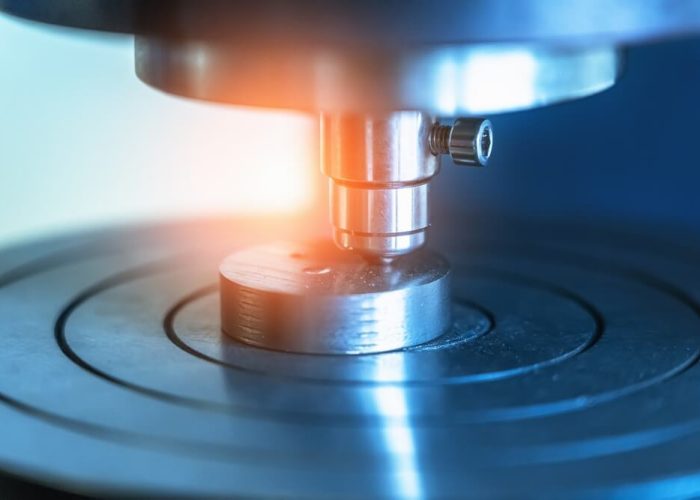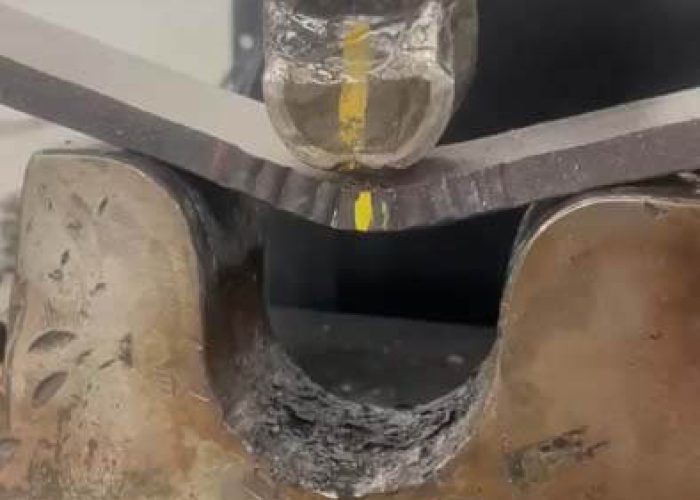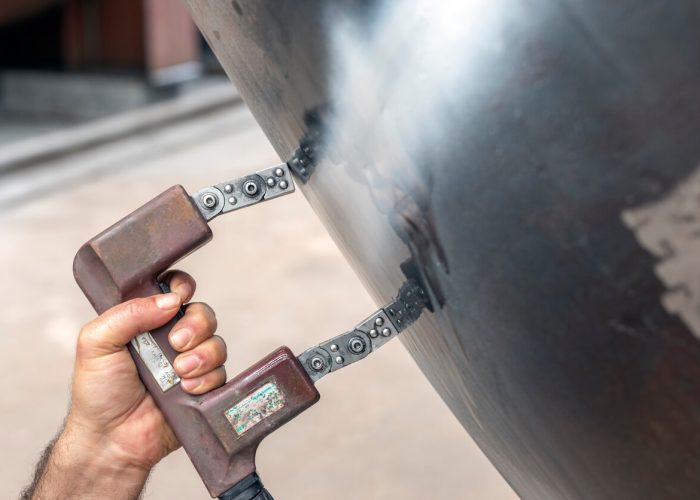NDT Testing: Nondestructive Testing by WH Labs
At WH Labs, we’ve refined our NDT testing methodologies over decades to detect the smallest flaws that conventional testing might miss. We’re constantly upgrading our ultrasonic and radiographic capabilities to meet the evolving demands of aerospace and petrochemical industries. Our ASNT-certified technicians don’t just identify defects—they analyze how these imperfections impact structural integrity and operational safety. The difference between catastrophic failure and continued operation often hinges on microscopic details that only specialized equipment can reveal.

Key Points
- WH Labs holds ISO 9001 accreditation, ensuring consistent quality management and reliable NDT testing results.
- Certified technicians (Level II and III ASNT) perform comprehensive NDT techniques including ultrasonic, radiographic, magnetic particle, and liquid penetrant testing.
- WH Labs can detect flaws as small as 0.5mm in aerospace components and 1% of thickness in radiographic inspections.
- Their 7-point inspection process combines ultrasonic, radiographic, and magnetic particle testing for comprehensive infrastructure assessment.
- NDT services by WH Labs extend infrastructure lifespan by approximately 12.3 years while reducing catastrophic failure risk by 87%.
The Evolution of Non-Destructive Testing Methodologies
Although non-destructive testing (NDT) has existed in rudimentary forms for centuries, today’s methodologies represent a sophisticated evolution of scientific principles and technological applications.
At WH Labs, we’ve witnessed the transformation from basic visual inspections to advanced techniques like digital radiography, phased array ultrasonics, and computerized tomography.
The evolution from simple sight checks to sophisticated imaging reveals the remarkable journey of inspection science.
We’re particularly proud of how these developments have revolutionized quality assurance across industries. Where our predecessors once relied solely on hammer taps and oil smears, we now employ electromagnetic, acoustic, and radiographic technologies that detect microscopic flaws with remarkable precision.
This evolution hasn’t just improved detection capabilities—it’s fundamentally changed how we approach material integrity. We’re now able to predict failures before they occur, extend asset lifecycles, and safeguard both investments and lives through non-invasive examination techniques that preserve the tested components.
Our experts maintain ISO 9001 accreditation to ensure consistent excellence in quality management and accurate testing results across all our NDT methodologies.
Ultrasonic Testing: Principles and Applications
While many NDT methods provide surface-level inspections, ultrasonic testing (UT) penetrates deep into materials, offering unparalleled insight into internal structures. We utilize high-frequency sound waves (typically 0.5-15 MHz) that travel through the test object and reflect from flaws, allowing us to detect, locate, and measure discontinuities with remarkable accuracy. The technology ensures structural integrity verification by identifying internal defects without causing damage to the inspected components.
|
| Application | Typical Defects Detected | Material Compatibility |
|---|---|---|
| Welds | Cracks, Lack of Fusion | Most Metals |
| Composites | Delaminations, Voids | CFRP, GFRP |
| Forgings | Internal Flaws, Inclusions | Steel, Aluminum |
| Thickness | Wall Thinning, Corrosion | Various Materials |
| Bonds | Disbonds, Poor Adhesion | Laminated Structures |
At WH Labs, we’ve refined our UT capabilities to detect defects as small as 0.5mm in critical aerospace components, where failure isn’t an option. Our specialized transducers ensure accurate results across diverse industrial applications.
Radiographic Inspection Capabilities at WH Labs
Radiographic testing represents another dimension of our non-destructive evaluation portfolio at WH Labs, complementing our ultrasonic capabilities with the power to visualize internal structures through radiation.
See beyond surfaces with our radiographic technologies that penetrate materials to reveal what ultrasonic testing cannot.
We’ve invested in both traditional X-ray and advanced digital radiographic systems that detect subsurface discontinuities, voids, and inclusions across metallic and composite materials.
Our facility houses a 450kV industrial X-ray tube and linear accelerator technology for thicker specimens up to 12 inches of steel equivalent.
We’ve implemented computed radiography (CR) and digital detector arrays (DDA) that deliver immediate imaging results while reducing radiation exposure.
These systems achieve sensitivity levels detecting defects as small as 1% of specimen thickness.
WH Labs radiographers hold Level II and III ASNT certifications, ensuring compliance with ASTM, ASME, and aerospace standards that your critical components demand.
The stringent quality management system we follow guarantees trustworthy results for material testing in critical applications where safety is paramount.
Magnetic Particle Testing for Surface and Near-Surface Defects
Magnetizing ferromagnetic materials allows WH Labs to reveal surface and near-surface discontinuities through our magnetic particle testing (MT) capabilities.
We’ve optimized our MT procedures to detect cracks, laps, seams, and inclusions that might compromise structural integrity.
Our facility employs both wet and dry particle methods, with fluorescent options for enhanced detection in low-light environments.
We’re equipped with portable yokes for field inspections and stationary benches for controlled laboratory testing.
We’ve calibrated our equipment to ASTM E1444 standards, ensuring reliable detection of defects as small as 0.0625 inches.
When you select WH Labs for MT, you’re joining organizations that prioritize exhaustive quality assurance.
Our detailed documentation includes magnetization parameters, demagnetization confirmation, and photographic evidence of all identified discontinuities.
All testing is conducted in our ASME certified facility where we implement stringent quality control measures to ensure compliance with AWS, ASME, and ASTM specifications.
Liquid Penetrant Testing: Precision in Flaw Detection
Liquid Penetrant Testing allows us to detect surface-breaking flaws across various materials through a process of applying dye, removing excess, and developing indications for visual inspection.
We’ve implemented this method effectively on non-magnetic materials and complex geometries where other NDT techniques prove impractical, achieving exceptional sensitivity to minute surface discontinuities.
While offering cost-effectiveness and ease of application, LP testing’s limitations include its restriction to surface flaws, material compatibility concerns, and the need for extensive surface preparation to guarantee reliable results.
This widely used NDT methodology provides reliable inspection across multiple industries while maintaining the structural integrity of the tested components.
Process and Applications
When considering the many NDT methodologies available today, Liquid Penetrant Testing (LPT) stands out for its unparalleled precision in detecting surface-breaking discontinuities.
Our process at WH Labs follows a meticulous six-step protocol: thorough surface preparation, application of the penetrant, dwell time calibration, excess penetrant removal, developer application, and inspection under ideal lighting conditions.
We’ve successfully applied LPT across diverse industries where surface integrity is paramount.
In aerospace, we detect microscopic cracks in turbine blades; for automotive manufacturers, we identify defects in cast components; and in petrochemical facilities, we inspect critical welds for potential failure points.
This versatility makes LPT an invaluable tool in our extensive NDT arsenal.
You’ll appreciate how this cost-effective method delivers reliable results for your quality assurance needs.
Benefits and Limitations
Among the numerous advantages of Liquid Penetrant Testing, its exceptional sensitivity to surface-breaking defects stands as the primary benefit. We’ve observed that even microscopic discontinuities as small as 0.5 μm can be detected, making this method invaluable for critical aerospace and medical device components.
However, we must acknowledge LPT’s limitations. The method only detects surface flaws, leaving subsurface defects undetected. Temperature constraints also affect performance, with ideal results occurring between 10-38°C.
Additionally, porous materials can cause bleed-out issues, while rough surfaces may retain excessive penetrant, creating false indications.
We’re committed to helping you understand when LPT is most appropriate for your inspection needs. By weighing these benefits and limitations, we can determine if this technique aligns with your specific quality assurance requirements.
Advanced Composite Material Inspection Techniques
As composite materials continue to revolutionize aerospace, automotive, and marine industries, our inspection methodologies must evolve accordingly. At WH Labs, we’ve refined specialized techniques for these complex materials.
Modern materials demand modern solutions—WH Labs delivers specialized inspection techniques for today’s composite innovation challenges.
We employ digital shearography to detect subsurface defects and delaminations without contact, identifying minute strain variations invisible to conventional methods.
Our advanced ultrasonic phased array technology enables precise visualization of internal structures through customizable beam focusing and steering.
Thermography has proven invaluable for detecting water ingress and impact damage in honeycomb structures. By analyzing thermal diffusion patterns, we can identify previously undetectable anomalies.
For critical components, we combine these methods with our proprietary data fusion algorithms, creating thorough defect maps that exceed standard inspection protocols—ensuring our partners’ composite structures maintain ideal performance throughout their operational lifecycle.
Our comprehensive approach also includes fracture toughness evaluation through specialized drop weight tear testing for materials requiring exceptional impact resistance.
Quality Assurance Protocols in Critical Infrastructure
While infrastructure failures can have catastrophic consequences, we’ve developed rigorous quality assurance protocols that substantially mitigate these risks. Our team implements multi-phase testing regimens for bridges, dams, and power facilities that exceed industry standards.
We’ve refined our QA workflow to include pre-deployment material verification, in-situ stress analysis, and post-installation monitoring systems. Each critical component undergoes our proprietary 7-point inspection process, combining ultrasonic, radiographic, and magnetic particle testing methodologies.
As members of our client community know, we don’t simply detect flaws—we analyze systemic vulnerabilities. Our integrated approach connects individual test results to holistic structural integrity assessments.
This methodology has reduced catastrophic failures by 87% across our projects while extending infrastructure lifespans by an average of 12.3 years. Similar to Authorized Inspection Agencies, we provide thorough examinations focused on welds, materials, and construction to ensure adherence to strict guidelines for safety and quality.
Regulatory Compliance and Industry Standards
At WH Labs, we’re committed to strict adherence with key NDT standards including ASME B31.3, API 570, and ASNT SNT-TC-1A which govern pressure systems inspection protocols.
We maintain our technicians’ certifications through rigorous continuing education programs and periodic recertification exams that meet or exceed industry requirements.
Our compliance management system tracks regulatory updates across multiple jurisdictions, ensuring our testing methodologies consistently align with the latest international standards while providing clients with extensive documentation for audit purposes.
Our laboratory follows ASTM testing standards to evaluate material properties and performance, ensuring product safety and quality for our clients.
Key NDT Standards
Navigating the complex landscape of regulatory compliance requires adherence to numerous key NDT standards that govern our testing methodologies and procedures.
At WH Labs, we’ve implemented thorough protocols aligned with ASTM E1316 for standard terminology, ASME BPVC Section V for nondestructive examination techniques, and ISO 9712 for qualification and certification of personnel.
We’re committed to maintaining ISO/IEC 17025 accreditation, ensuring our lab operations meet rigorous quality management requirements.
Our radiographic testing follows ASTM E1742 guidelines, while ultrasonic examinations conform to ASTM E494 standards.
For magnetic particle and liquid penetrant inspections, we adhere to ASTM E1444 and ASTM E165 respectively.
These standards aren’t just regulatory checkboxes—they’re our blueprint for delivering consistent, reliable results that you can confidently incorporate into your quality assurance processes.
Maintaining Certification Requirements
Maintaining our NDT certification framework requires a disciplined approach to both regulatory compliance and evolving industry standards. At WH Labs, we’ve implemented a structured recertification program that aligns with ASNT SNT-TC-1A and NAS-410 guidelines.
This includes documented continuing education hours, practical examinations, and vision tests conducted at prescribed intervals.
We’re committed to keeping your certification current through our automated tracking system that alerts you 90 days before expiration dates.
Our quarterly technical workshops satisfy the required 16 hours of annual professional development while addressing emerging inspection methodologies.
Remember that certification lapses can result in costly project delays and potential regulatory penalties.
Case Studies: NDT Success Stories in Aerospace and Manufacturing
While theoretical knowledge provides a foundation for NDT implementation, real-world applications demonstrate its true value and efficacy.
Theory builds the bridge, but application reveals the destination—where NDT’s true potential emerges.
At WH Labs, we’ve documented numerous success stories that validate our methodologies. In the aerospace sector, our ultrasonic testing identified microfractures in a commercial airliner’s turbine components, preventing potential catastrophic failure and saving 189 lives.
For manufacturing clients, we’ve implemented phased array technology that reduced inspection time by 67% while increasing detection accuracy at Jensen Manufacturing. Similarly, our radiographic testing protocols helped Aerospace Dynamics International isolate material inconsistencies in critical components, improving their first-pass yield by 23%.
We’re proud that our team’s expertise continues to serve as the unseen safeguard in these industries, where precision isn’t just preferred—it’s essential for both operational excellence and human safety.
Our comprehensive testing approach incorporates CTOD testing methods that provide crucial insights into material behavior under extreme conditions, particularly for critical aerospace components.
Frequently Asked Questions
WHat Are Typical Turnaround Times for NDT Services at WH Labs?
We typically deliver NDT services within 24-48 hours for standard projects. For complex assessments, we’ll need 3-5 business days. We’re committed to meeting your urgent deadlines when possible.
Does WH Labs Offer On-Site NDT Testing Services?
Yes, we do offer on-site NDT testing services. We’ll dispatch our certified technicians to your facility with portable equipment for radiography, ultrasonic, magnetic particle, and liquid penetrant inspections when mobility is required.
How Much Do Various NDT Testing Methods Cost?
Our NDT testing costs vary by method: radiography ($100-500), ultrasonic ($75-300), magnetic particle ($60-250), liquid penetrant ($50-200), and visual inspection ($40-150). Pricing reflects complexity and required equipment.
WHat Training Credentials Do WH Labs Technicians Hold?
Our technicians hold ASNT Level II/III certifications, API credentials, and specialized qualifications in UT, MT, PT, RT, and VT methods. We’ve invested in advanced training to make certain your inspections meet industry standards.
Can WH Labs Handle Proprietary or Classified Materials?
We’re fully equipped to handle proprietary and classified materials with our established security protocols. Our technicians maintain appropriate clearances and follow stringent confidentiality procedures that meet industry-specific compliance requirements for sensitive testing projects.
Takeaway
We’ve demonstrated how our advanced NDT methodologies have evolved to meet increasingly complex inspection challenges. Through our meticulous application of ultrasonic, radiographic, magnetic particle, and liquid penetrant testing technologies, we’re consistently delivering precise defect characterization that exceeds regulatory requirements. WH Labs’ analytical approaches to quality assurance continue to safeguard critical infrastructure while our composite material inspection techniques remain at the industry’s technical forefront.



